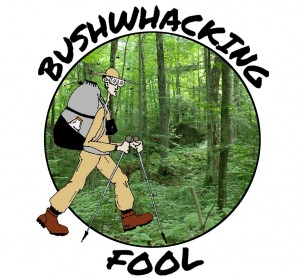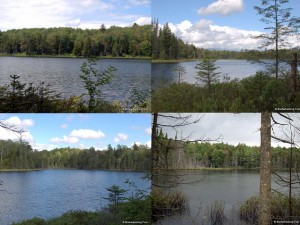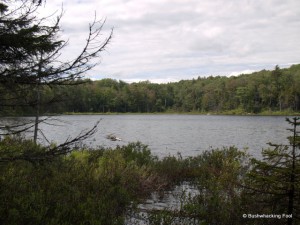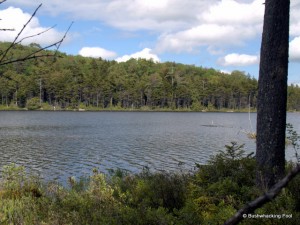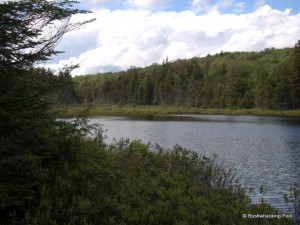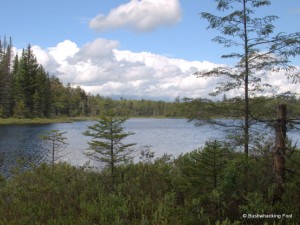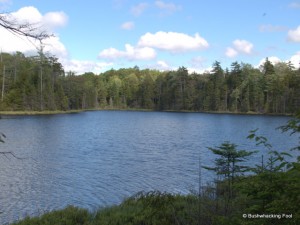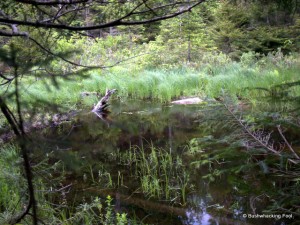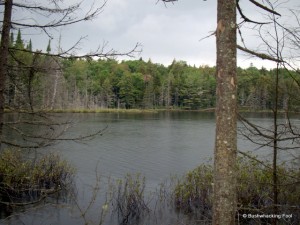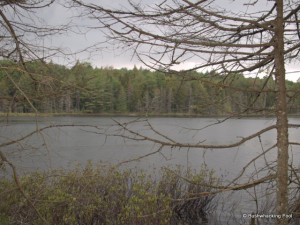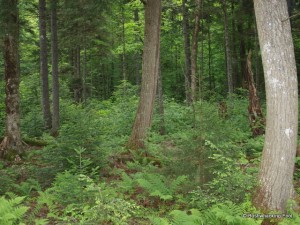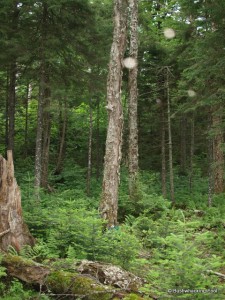Now with the trail hiking under my belt until the return trip to retrieve my vehicle at the Bear Pond Road, it is time to leave my last tether to civilization (i.e. the Upper South Pond Trail) behind and begin the long bushwhack southeast toward my final destination for the night at Lower South Pond.
Leaving the trail behind (point #3 on the accompanying map), I enter the surrounding forest, still wet from the rain earlier in the afternoon. The darkness brought about by the gathering clouds continues, as does the distant rumbling. Since the low sound does not appear to be growing louder, I continue to believe it is artillery from far off Fort Drum. It can be aliens bombing the windmills on the Tug Hill, as long as it is not an imminent thunderstorm.
Off to my left and down slope is Upper South Pond, with an open wetland separating me from the open water. The banjo twang of many green frogs emanates from the direction of the wetland, while a seemingly infinite number of red-eyed vireos sing all about me. Joining the cacophony is a single blue-headed vireo and a yellow-rumped warbler, both singing from within the conifers growing around the shoreline of the pond.
View Day One, Part Three in a larger map
Section Stats:
Date: June 17, 2013
Length: 2.1 miles (3.3 total daily miles; 3.3 total trip miles)
Difficulty: Moderate
The wetland penetrates southward into the forest from the pond’s shoreline, requiring a detour from my original southeast direction. When I finally get around the wetland, I head due east toward the shoreline of Upper South Pond, arriving within a short time at the middle of its southern shoreline (point #4). With water levels so high because of the wet late spring, the indistinct shoreline increases the difficulty in finding a good view of the entire pond.
Upper South Pond is the smallest of the three named south ponds (the fourth unnamed one between Middle and Lower South Ponds is even smaller), with its east-west length being three times its width. Although the trail, which I left only a short time ago, ends at a clearing on the northern shore, scanning the northwestern corner with my binoculars yields only a single candidate, located almost directly opposite my location.
The late afternoon hour prevents lingering too long, despite the sky becoming brighter and less threatening. With three more ponds to visit before reaching my intended campsite for the night, and miles of unknown conditions in what could easily be dense and wet forest, there is little time for dilly-dallying.
Pulling my compass out from beneath my rain jacket, it indicates a bearing of 124 degrees to the southwestern corner of Middle South Pond. Following the bearing, I bushwhack in the indicated direction, keeping just a short distance from the shoreline, where the hardwood forest makes the going easier.
As I approach Middle South Pond, the forest takes an increasingly coniferous nature with an open wetland visible through the trees. Instead of attempting a swampy crossing, I break south staying just beyond the edge of the conifers until I can once again bushwhack northeast to Middle South Pond’s southwestern shore.
Middle South Pond is a much larger water body than its little cousin to the northwest, with an irregular shoreline, including numerous bays of varying depth and size. Although larger in surface area, its maximum depth is about as half, at least according to the Adirondack Lakes Survey done in the mid-1980’s.
Upon arriving in the southwestern corner of the pond (point #5), the first thing I notice is unrelated to this beautiful wilderness pond; instead, it is the brightening sky. Much of the sky is now clear and bright blue, with only a scattering of clouds remaining, swiftly moving across the sky in the stiff breeze.
Maybe, a downpour is not as inevitable as I thought earlier. Then again, this is the western Adirondacks, where rain can seemingly appear out of nowhere with only a moment’s notice. If that!
Waterfowl are plentiful here, especially compared to the lack of any back at the previous pond. Perhaps the irregular shoreline is the cause, or maybe it is just plain luck. A female common goldeneye swims along, leading her nine young away from my location, heading across the narrow bay to the relative safety of the far shore. Near-by, a female hooded merganser takes her six charges off to the east and open water. All the retreating leaves me feeling a little bit unwanted and unloved.
In addition to the waterfowl, other bird life appears quite abundant here too. A white-throated sparrow sings near my location, belting out its ode to Canada, as both a blue jay and yellow-rumped warbler add their distinctive songs to the mix. A turkey vulture flies over the lake, soaring above the treetops, apparently using the windy conditions to its advantage. To the west, up the channel to Upper South Pond, an olive-sided flycatcher sings its “quick-three-beers” song, expressing my own current thirst for a good brewski.
From Middle South Pond, I bushwhack to the southeast, roughly staying parallel with the pond’s shoreline for about half its length. At this point, the shoreline continues due east, while I pull away to the southeast, heading straight for the northwestern corner of the small pond between Middle and Lower South Ponds, which I dub Little South Pond. The channel between them may have been more substantial at some point, as the Adirondack Lakes Survey considered the little pond just a part of Middle South Pond.
As I approach the smaller pond, the forest becomes thicker, wetter and includes a mixture of dense hobblebush, exposed rock and downed logs. Avoiding an open area along shore, I reach the western shore of the small pond (point #6), where two beavers act as a welcoming committee. The large beavers display their usual hospitality by frequently slapping their flat tails against the water.
At least this time they do not take me unawares and nearly give me a heart attack.
Little South Pond appears as a smaller version of Middle South Pond, just rotated about ninety degrees east. Although given little respect, it is unnamed on the map after all, the small pond remains attractive, and unlike its brethren has several stately white pines along its shoreline.
The avian community refuses to act as second fiddle to the resident beavers, as two ducks take cover along the far shore before giving me an opportunity to identify either one to species. Fortunately, my waterfowl skills do not go completely to waste, as a female common goldeneye flies by from the south, landing on the water in the bay to my north. A white-throated sparrow and a song sparrow sing nearby, while a yellow-bellied sapsucker chatters for an unknown reason back in the forest behind me. A blue jay flies into a nearby tree, frequently cocking its head one way and then another, as if trying to figure out what I am.
With it almost five in the afternoon, I soon depart the little pond heading southeast, toward a likely crossing over the Lower South Pond outlet stream. Although a significant distance out of my way, a closer crossing appears unlikely along the wide stream, especially with the currently elevated water levels.
The terrain starts out rolling, with the forest becoming increasingly dark and uninviting, or perhaps that is the darkening sky. After a few short climbs and descents, a consistent climb begins as I work my way over a ridge separating Lower South Pond’s inlet from its outlet. The fifty-foot climb finally ends at a steep descent, with the sound of a cascading stream far below.
Carefully making my way down the steep ridge in a serpentine manner through the conifer-lined descent, I fear not finding a viable crossing, as my Garmin Legend GPS indicates I am well east of where originally intended. The sound of rushing water increases my anxiety, but good fortune is on my side this time, as a convenient log straddles the stream at its narrow point just downstream.
I shuffle across the wet log carefully, as a single slip could transform a convenient crossing into a wet disaster.
After making it to the far shore without mishap, my concentration turns to the sky, which has darkened once again, the clouds taking on an especially threatening shade of gray. Picking up my pace, I work my way back east toward Lower South Pond, making up all the distance required to locate a satisfactory stream crossing. The thickening forest along the stream has other plans, as it appears to do everything it can to impede my progress.
When I start working my way toward Lower South Pond’s southern shore, random raindrops begin landing on my arms and legs. At first, it is difficult to tell whether they are dropping from the soaked foliage, or the precursor to a rainstorm, but given the angry sky overhead, I expect the worst.
If the threat of rain is not bad enough, the first blackflies of the trip appear, just to add insult to injury. Luckily, they appear only in small numbers, making their nuisance manageable. Perhaps they are merely looking for a place to sit out the inevitable rainstorm.
Sorry gals, not in my clothes!
Reaching the pond’s shoreline, the source of the random drops becomes obvious, as the ripples from a multitude of tiny raindrops spread out on the surface of the pond. Lower South Pond is the largest of the south ponds, with a shape suggesting an upside down turtle. Unfortunately, its most interesting feature, a small, protected cove connected to the main pond by a narrow channel (the head of the turtle), was not on my agenda this trip, although there is still a slight chance that I might return from Sitz Pond this way instead of using the Upper South Pond Trail.
Despite the threat, I cannot help myself but take a brief respite to enjoy the surroundings and reflect upon the day’s journey, followed swiftly by a frantic search for an acceptable campsite, where the criteria quickly becomes less strict as the intensity of the falling rain picks up.
With an acceptable campsite located (point #7), I hurriedly begin setting up my tarp, with the hope of beating any imminent downpours. In my haste, the guidelines of my tarp get all entangled, which is normally not such a big deal, except I realize it AFTER my shelter is already half up.
While untangling the guidelines, the rainfall naturally increases in intensity, making it all the more difficult. When I finally untangle the lines, it takes little effort before the tarp is completely up and ready to protect my equipment and myself, the rain suddenly stops. Apparently, putting on one’s rain gear is not the only thing that magically reduces the odds of rainfall; putting up the tarp is equally effective.
Although remnant raindrops continue falling from the surrounding foliage, giving the illusion of rain, I busy myself with setting up my campsite for the night. The itinerary consists of food line hanging, water filtering and dinner cooking, performed while fully ensconced in my wet rain gear, whose waning magical properties just did not come through for me this time.
As the clouds separate, and the sun reemerges, the hope of a dry day tomorrow reignites my enthusiasm. If only such hope could dry out my damp interior clothing as well, then I would be all set. Unfortunately, the sky darkens during dinner and rain begins to fall anew while brushing my teeth, dampening any such foolish notions of a dry morning.
The rain falls lightly, so instead of retreating under the tarp for the night, I slowly pick my way through the dense and thoroughly soaked foliage to the southern shoreline of the pond. A female common goldeneye, with five young, swims along the opposite shore of the channel leading to the pond’s outlet. The ducklings religiously follow their mother, as she hides them into the shoreline vegetation for the night.
Looking out into the middle of the pond, I spy something that looks surprisingly like a common loon floating on the surface. Retrieving my binoculars from within my rain jacket, and waiting the obligatory time for the condensation to abate, I verify my suspicions, as it turns out to be a common loon. And on a water body supposedly fishless too.
As the rain starts falling steadily again, I flee to my tarp, discard my rain gear and crawl into my shelter for the night. The pitter-patter of rain bouncing off my tarp makes it too difficult to even listen to my radio, so within a half hour, I surrender and succumb to a restful night’s sleep at the early hour of eight-thirty in the evening.
All the while, preparing myself for a very wet and miserable morning. But, at least I made it all the way to Lower South Pond today.
Affiliate Disclaimer: Some links within this blog post may send you to a retailer website. If you chose to purchase any product on that site at that time, this author receives a small commission. These commissions provide compensation for the author’s time and effort necessary to provide the content at the Bushwhacking Fool.
